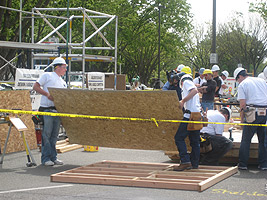
Handling Material
As trainers of your students and young workers, you are responsible for educating them on workplace health and safety including (but not limited to): safe work practices, worker's rights, the importance of learning in safety meetings and other trainings, and complying with rules and regulations. To reduce the risk of injury and increase productivity, see the information below:
When training your students and young workers make sure and review with them their information on Handling Materials.
Cal/OSHA has an Ergonomics Regulation which relates to moving and handling materials safely. This regulation is called Repetitive Motion Injuries (RMIs) and is in Title 8 of the California Code of Regulations (T8CCR 5110). The following is a brief overview and summary of the Cal/OSHA Ergonomics Regulation. T8CCR 5110 requires, in part, that if more than one soft tissue injury caused by performing exactly the same work activities has occurred within the past 12 months, the employer must establish an ergonomic program to minimize RMIs. The program must include evaluating the worksite, control of exposures, and training.
For your reference, the complete set of Title 8 regulations can be found at:
www.dir.ca.gov/samples/search/query.htm
The Cal/OSHA regulations related to safety in construction can be found in Chapter 4. Division of Industrial Safety, Sub -Chapter 4. Construction Safety Orders (Sections 1500 - 1938).
- Reorganize the Work and Relocate Materials
- Reorganize work tasks to eliminate unnecessary lifts and movement of materials
- Arrange for materials to be off loaded to staging areas close to the work area. This will reduce the distance loads need to be lifted or lowered, carried, and pushed or pulled
- Keep it off the ground
- Redesign jobs to avoid lifting/lowering or moving materials to or from the ground. For example arrange for pallet load of materials to be positioned within workers' power zone, not on the ground
- Set site rules to raise the work off the ground. Require the use of sawhorses or benches so workers do not need to bend over as often
- Make Equipment Available for moving or lifting loads and encourage its use.
- Make sure students and young workers are thoroughly trained before using the equipment and closely supervised.
 Use Team Lifting
Use Team Lifting
- Encourage students and young workers to help each other when lifting or moving materials.
- Use Lighter Weight Materials
- Whenever possible select the lightest weight materials for the job
- Vary Work Assignments for Students and Young Workers
- Assign tasks where they lift or move materials and then rotate them to other tasks where they do not handle materials
- Alternate heavy lifting or hard physical tasks with lighter ones
- Use Safer Techniques When Manually Moving or Handling Loads
- Encourage rest breaks to help relax tired muscles
- Before lifting or handling materials
- Ensure path and walkways are clear
- Test the load for weight and stability. Use extra caution on loads that are unstable
- Ensure you have clear access to the load
- Move close and to the center of the load to prevent twisting, reaching or bending
- When lifting loads by hand:
- Keep the lifts within your "power zone" (above the knees and below your shoulders). This is where your body has the most power.
- Face the load
- Bend your knees and keep your back straight
- Bring the load close to your body
- Get a secure grip using both hands
- Use your legs to push up and lift the load, not the upper body or back
- Breathe out and tighten your stomach as you lift
- Do not twist your body, instead move your feet
February 2010

